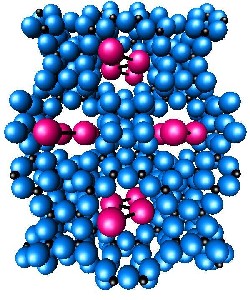Close-Up of Atomic Cave-Dwellers

Researchers have captured the most detailed pictures yet of particles crowded into an industrially useful nanoscale sponge. They extended an old method for analyzing x-ray diffraction data to a zeolite–a porous crystalline substance–filled with metal ions. The result, appearing in the 12 August print issue of PRL, confirms that this material is the first room-temperature stable electride, a class of compounds with curious electrical, magnetic, and optical properties that may eventually have applications as nanoscale devices.
Zeolites are crystals riddled with a network of atomic-scale hollows. These channels can soak up certain atoms, ions, or small molecules in favor of others, so zeolite powders are often used in detergents to soften water and in oil processing to catalyze chemical reactions.
Researchers are particularly interested in zeolites filled with metal atoms such as cesium. Previous studies hinted that cesium atoms in the silica (SiO2) zeolite ITQ-4 acquired positive charges. If true, this would constitute a stable inorganic electride–an ionic solid composed of a positively charged lattice and a sparse “electron gas.” All other known electrides are made from organic molecules, but these tend to degrade rapidly at room temperature. Confirming the cesium-doped zeolite’s status as an electride wasn’t possible before because the disordered atoms thwarted conventional crystallography.
So Valeri Petkov of Michigan State University in East Lansing and coworkers applied a technique called atomic pair distribution function (PDF) analysis, used in the past to study disordered materials like glasses and liquids, and, more recently, crystalline materials. The cesium-laced ITQ-4 is “somewhere in between” a crystal and a disordered solid, Petkov notes. When x rays pass through a pure crystal, they generate discrete spots of intensity called Bragg peaks, which reflect the repetitive elements of the sample. Disordered components such as the cesium smear out the peaks into a diffuse pattern. PDF is a way of extracting information from both kinds of signal.
The group sent x rays from the National Synchrotron Light Source at Brookhaven National Laboratory in Upton, New York, through the powdered material and applied the PDF technique. By comparing their results with models of ITQ-4 containing either neutral or charged cesium atoms, they concluded that only positively charged cesium fit the data, Petkov says. Inside the channels, the ions seem to be arranged in zigzag chains. Co-author Andrew Ichimura of San Francisco State University says the real significance of the research is that “now we have the possibility to develop applications for electrides,” such as detectors, catalysts, and electro-optics for communication.”
The mere performance of the experiment “is a testament to how far PDF analysis has come,” says Brian Toby of the National Institute of Standards and Technology in Gaithersburg, MD. ”I’m very heartened by that.” Until now the method has almost exclusively been confined to dense materials that scatter x rays strongly, and therefore give strong diffraction signals, he says. Given the many industrial applications of zeolites, says Toby, it’s exciting to finally see what the atoms inside them are up to.
–JR Minkel
JR Minkel is a freelance science writer in New York City.


